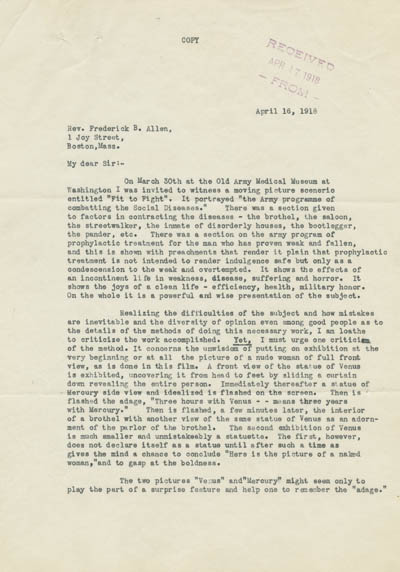Collections Online
Letter (retained copy) from J. Frank Chase to Frederick B. Allen, 16 April 1918
To order an image, navigate to the full
display and click "request this image"
on the blue toolbar.
-
Choose an alternate description of this item written for these projects:
- Main description
[ This description is from the project: Staff Favorites ]
Born to a prominent Boston family in Boston in 1861, Godfrey Lowell Cabot became a successful businessman and manufacturer. He was a naval aviator in World War I. He was notably active in the New England Watch and Ward Society, a private institution with considerable political influence that sought to monitor social and business activities for what they perceived to be dangers to public morality. Much of their effort focused on censoring books and plays and ending gambling.
“Did it -- as Chase feared -- encourage soldiers to consider 'chance[ing] disease for a moment’s pleasure'?”
MHS Reference Librarian Anna Clutterbuck-Cook on the Watch and Ward Society's "Fit to Fight" letter
This letter, between two members of the New England Watch and Ward Society-- a citizens group dedicated to the policing of obscene literature-- discusses a public health film made to screen for soldiers mustered during WWI. The author of this letter airs his concerns about the effectiveness of the film in deterring sexual activity in the armed forces-- particularly his concern that depictions of a statue of Venus are more likely to incite lust rather than its opposite. I would love to know more about the reception of the film "Fit to Fight" by the soldiers who viewed it as part of their training. Was the film successful in deterring participation in relational sex activities (paid or unpaid) that would spread sexuality transmitted infection, or did it-- as Chase feared-- encourage soldiers to consider “chance[ing] disease for a moment’s pleasure”? To learn the reception of "Fit to Fight," historians would need to turn to personal correspondence, personal reminiscence, and official war department documents related to the treatment of STIs and other records related to the sexual expression of soldiers. It may be tempting to view the concern over statues inciting lust as a quaint historical anecdote, yet as recently as 2002, Attorney General John Ashcroft made headlines when he ordered the statue Spirit of Justice (1933) shrouded while giving public addresses due to the statue’s bared breasts. Clearly, our national debates around depictions of human bodies-- particularly those with female-typical anatomy-- are not confined to the past.

